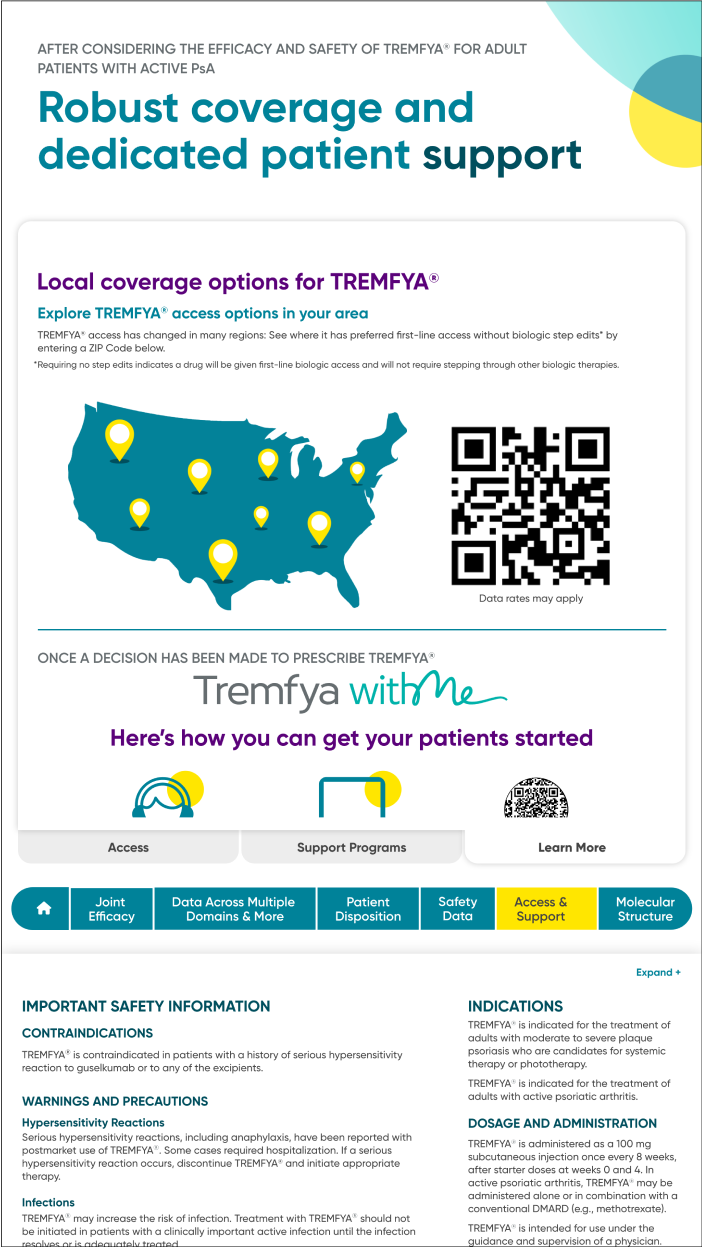Tremfya
Pharmaceutical
Convention Panel
Overview
Janssen Biotech participated in a medical convention geared toward healthcare providers. Their booth for Tremfya, a plaque psoriasis treatment, was operated by a minimal staff of drug representatives. They were at a disadvantage, as their ability to speak to the HCPs (healthcare providers) roaming the convention hall was limited by the number of one-on-one interactions they could have. This made it likely that HCPs would miss the booth and remain uninformed of the benefits the drug could have for their patients. Our team was consulted to design a solution.
The problem
Healthcare providers attending the convention need to be able to independently access information about Tremfya, so they can learn about its benefits and better treat their patients.
The role
As the primary designer on the team, I collaborated with our UX partners, copy, and art teams to translate the client’s messaging into an intuitive, easy-to-navigate, user-operated touchscreen experience.
Design goals
Multi-user interactivity
Multiple users should be able to simultaneously benefit from the experience.
Non-linear information access
Users should be able to directly access information most relevant/important to them.
Program spotlight
Users should be driven to the Tremfya withMe support page to learn about and enroll their patients in the program.
Initial ideation
Details about the booth and the nature of the panels, including whether they would be in-wall or freestanding units, were in flux at the onset of the design process. Additionally, the manuscript, site map, and wireframes were scheduled to be produced simultaneously, leading to difficulties in translating initial ideas into layout.
Wireframes
As content was still being developed, wireframes reflected a rough idea of our proposed means of navigating primary and sub-content, including the client requested inclusion of the coverage locator tool from the HCP website.
Layout design
Upon the handoff of the first completed draft of the manuscript from copy to our experience design team, the layout was built and skinned with Janssen's branding material. The initial layout was routed through the broader creative and account teams to ensure alignment before presenting to the client.
First client review
Feedback and takeaways
Reactions to our initial designs were positive, and there was clear feedback provided that allowed us to iterate upon our work.
Clients wanted to incorporate the coverage locator tool (similar to how it existed on their HCP website) as a means of providing information while simultaneously collecting data.
Clients felt there was an overuse of their darker brand colors, making the experience feel heavy.
Clients requested elements of animation be incorporated into the design.
Clients chose to go with 6’, freestanding touchscreen kiosks.
Final design
The final design was reskinned to adhere to the client’s desire for a lighter/brighter overall feel while still clearly displaying their brand colors. The experience was reformatted to function better as a freestanding touchscreen kiosk. As the kiosk was quite tall, navigation was relocated from the top of the viewport to a height more accessible to the average user, while still providing ample tap points for primary and sub-navigation.
Featured improvements
Rethinking the coverage locator tool
Rather than forcing users to individually input information (in the process broadcasting their personal details across the convention hall), we recommended replacing the tool with a QR code to drive users to the locator tool on the HCP site on their mobile devices. This allowed an unlimited number of users to utilize the tool simultaneously, helping prevent drop-off while keeping their experience discrete and personal.
Original
Final
Closing thoughts
The implementation of the website and ordering system increased sales by 250%. By providing a clearer outlook on ordering trends, it reduced food waste and business costs. It allowed users to secure items they wanted, eliminating the uncertainty and time constraints of the first-come, first-served wholesale model. Whereas wholesalers previously determined inventory types and quantities, the new model's inventory was based on sales trends, putting the power into the hands of the consumer.

























